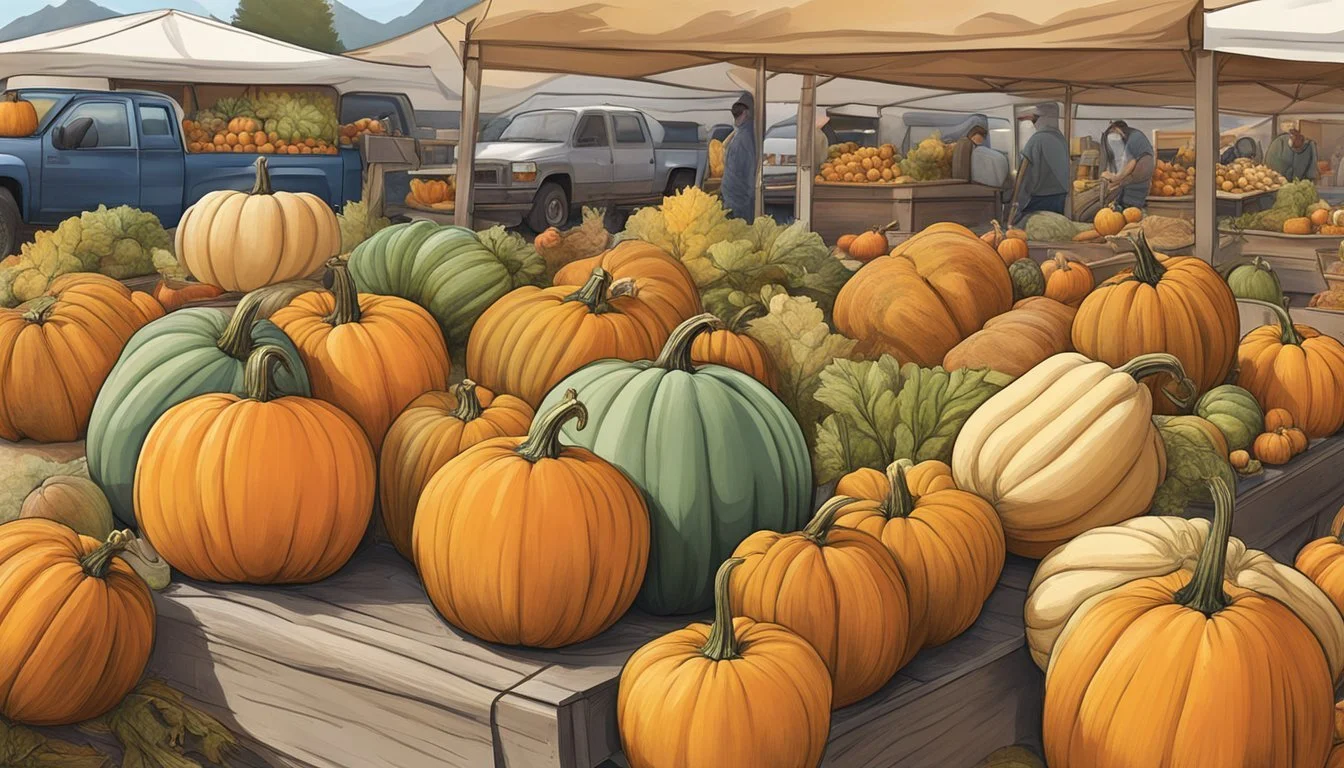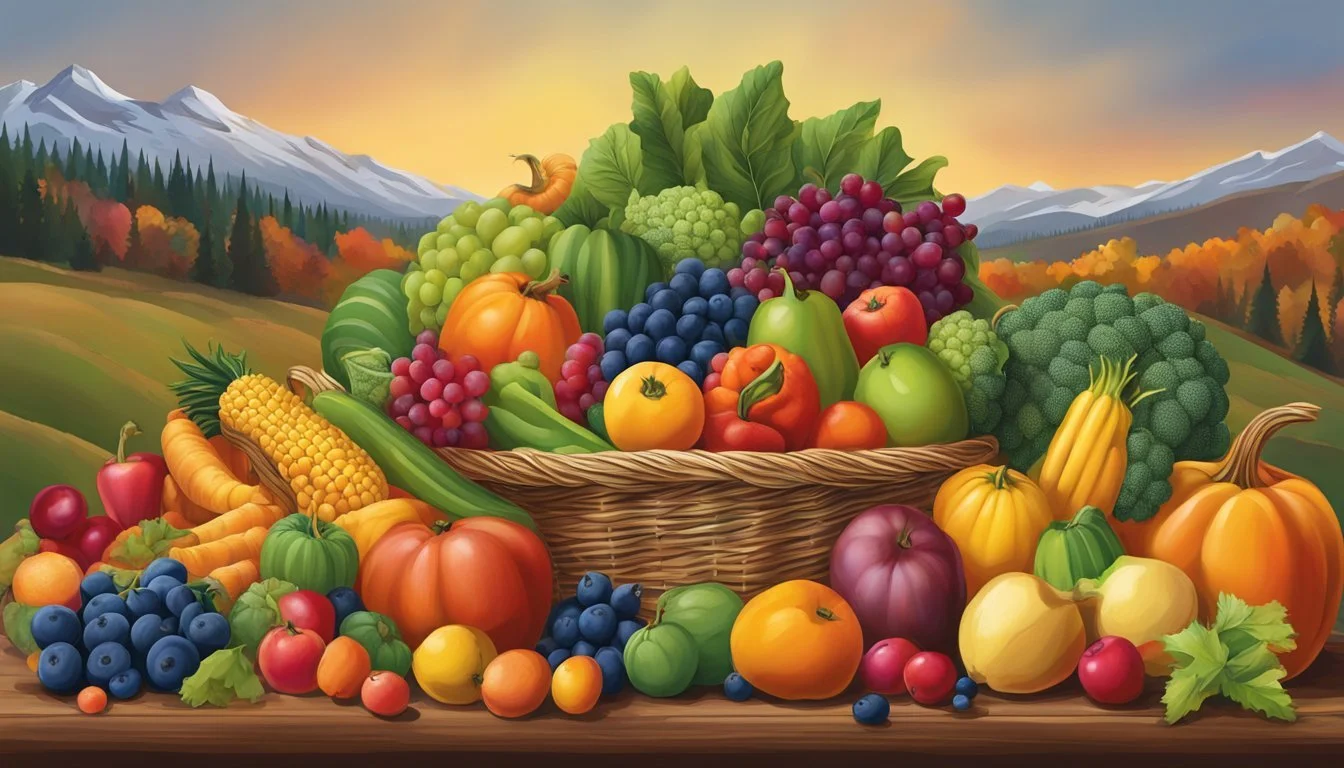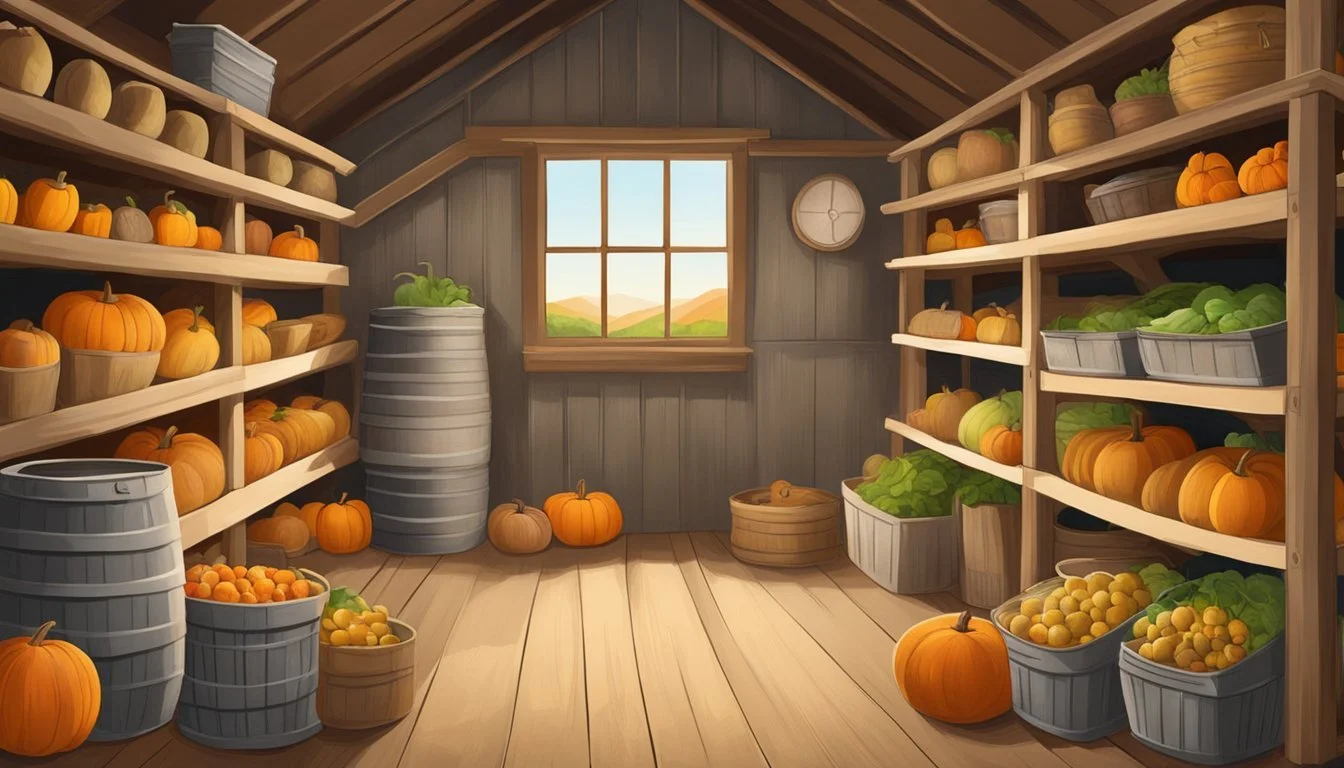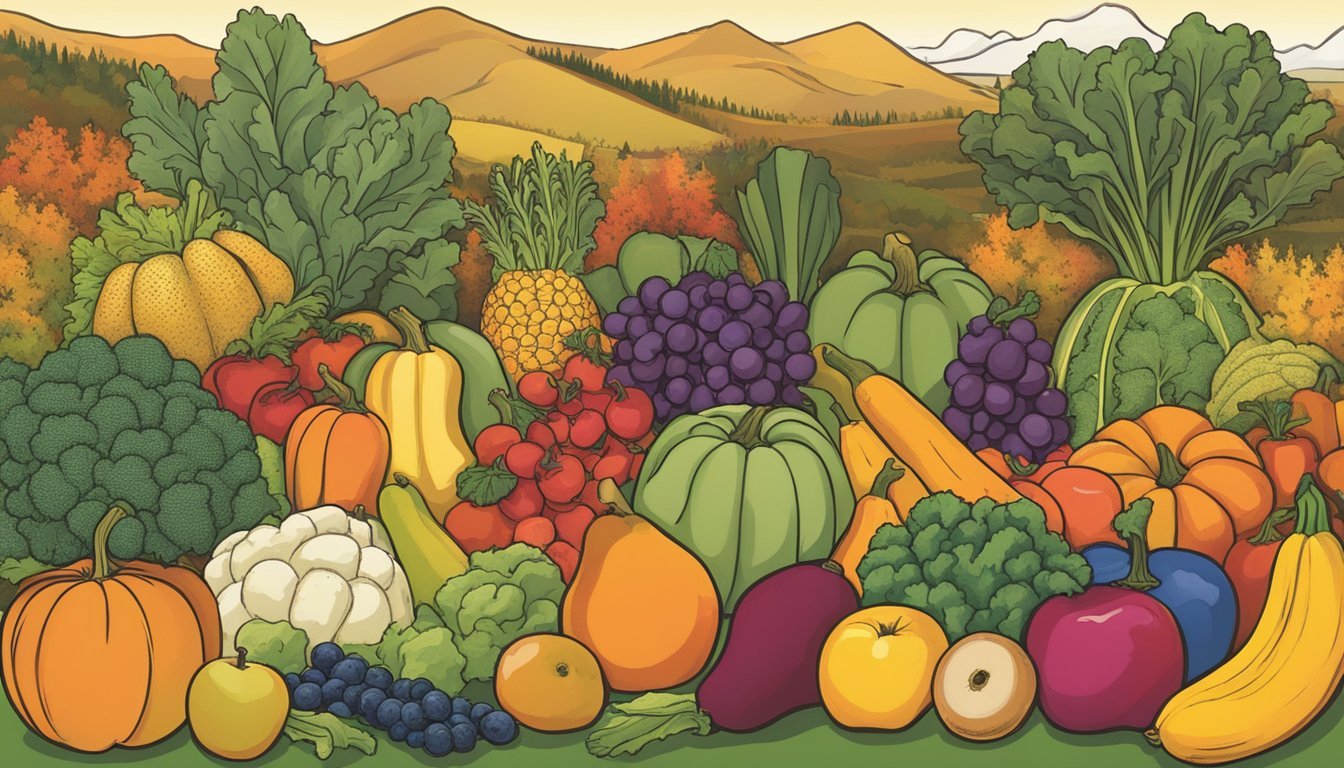Montana Seasonal Fruit & Vegetables in November
A Guide to Local Harvests
This Article is Part of our Montana Seasonal Fruit & Veg Calendar
In Montana, the month of November marks a transition in the agricultural calendar as the state's rich farmlands yield the last of the fall harvest. The fields and orchards, having benefitted from the long, sunlit summer days, offer a bounty of produce before the winter sets in. During this time, residents and chefs alike turn to seasonal fruits (What wine goes well with fruits?) and vegetables to capture the flavors of the season. Access to fresh, locally grown produce such as apples (how long do apples last?), which continue to be harvested, and root vegetables like beets and carrots, becomes a focal point for nutritious and hearty meals.
The availability of produce like cauliflower, which is typically harvested from August through November, provides an opportunity for savory autumnal dishes. Similarly, greens such as chard maintain their presence in the market, allowing for a continuation of nutritious options. As the temperatures cool, these robust vegetables take center stage in the Montana diet, favored for their ability to withstand the chill of approaching winter days.
The cultivation and consumption of these November offerings reflect Montana's agricultural resilience and commitment to seasonal eating. Consumers prioritize locally sourced ingredients, supporting the state's economy and sustainable farming practices. This underlines the spirit of Montana's communities that value what their land can yield and the seasonal cadence that dictates their cuisine.
Understanding Montana's Seasonal Produce
Montana's agriculture is rich and varies with the seasons. Emphasizing the role of the regional climate, the benefits of seasonal eating, and what November offers, provides insight into the state's bounty during this transitional month.
Significance of Regional Climate
Montana's climate greatly influences its agricultural timetable. The fall to winter shift sees colder temperatures and reduced daylight hours, which are critical factors for the growth and harvesting of crops. As November falls squarely in this transition, it typically marks the end of the harvest season for many crops.
The Merits of Seasonal Eating
Consuming seasonal produce ensures that one enjoys fruits and vegetables at their peak of freshness and nutritional value. In Montana, eating seasonally also supports the local economy and reduces the environmental impact associated with long-distance food transport.
Navigating November's Harvest
Montana's November harvest offers a range of fresh produce before the winter sets in. Consumers can find root vegetables, such as carrots and potatoes, which store well into the colder months. Late harvest items like winter squash and pumpkins are also available, along with apples and pears. It's crucial to note that while some summer crops have ended, greenhouses and storage techniques extend the availability of certain products like herbs and onions.
Fruits in Season
Montana offers a limited but diverse selection of fruits in November, as the harvest season for many summer varieties has ended. The focus this time of year shifts to hardier fruits that store well or those that have a later season.
Pome Fruits
In November, pome fruits—namely apples and pears—are at their prime in Montana. These fruits are known for their storage capability and hardiness in cooler temperatures.
Apples: A variety of apples are available, including types that are perfect for eating fresh or for making pies and cider.
Pears: Pears during this month are often sweet and ideal for both raw consumption and culinary uses.
Berry Varieties
Although the peak season for berries has passed, some hearty varieties of berries, like cranberries, are in season.
Cranberries: These tart berries are typically harvested in the fall and remain available into November. They are often used in sauces and baked goods.
Exotic Selections
Montana's November fruit selection also includes non-native fruits that reach maturity in late fall, offering a taste of the exotic as the winter approaches.
Pomegranates: Known for their jewel-like seeds and rich flavor, pomegranates are available and add a splash of color and nutrition to the fall palette.
Persimmons: These sweet fruits have a honey-like taste and are typically ready for harvest in late fall, making their appearance in markets during this time.
Vegetables and Roots Spotlight
November in Montana is a time when hearty vegetables and roots come into focus, offering a plethora of nutritious options that can withstand the cooler temperatures.
Cruciferous Vegetables
Cruciferous vegetables like brussels sprouts (how long do brussels sprouts last?) and cabbage thrive in the cold and can often be harvested well into the winter months. They bring both texture and flavor to a variety of dishes, from roasted vegetable medleys to hearty stews.
Brussels Sprouts: Best when frosted; this can sweeten the sprouts.
Cabbage: Available in green and red varieties, offering versatility in the kitchen.
Root Vegetables
Hearty root vegetables are at their best in November. Carrots and beets offer sweet, earthy flavors, while rutabagas and turnips provide a robust presence in fall dishes.
Carrots: Retain sweetness, even post-frost, and are ideal for roasting or in soups.
Beets: Harvest continues through fall; great for boiling or pickling.
Rutabagas & Turnips: Optimal for mashing or adding substance to stews.
Leafy Greens
While some might not associate leafy greens with November, certain cold-tolerant varieties like kale, (What wine goes well with kale?) spinach, and chard can still be found. These greens can withstand frost, which often enhances their flavor.
Kale: Hardy and can grow in colder temperatures, sweeter after a frost.
Spinach & Chard: Can survive light frosts; ideal for nutritional boosts in salads and warm dishes.
Culinary Inspirations
In Montana's November, the seasonal produce inspires a symphony of flavors, perfect for crafting hearty dishes and vibrant salads. This section explores how to pair these ingredients with complementary herbs and spices to elevate every meal.
Recipes and Pairings
Montana’s seasonal produce in November lends itself to a variety of recipes. For root vegetables like rutabagas and parsnips, one could consider roasting them to enhance their natural sweetness, serving as an ideal side for savory dishes. Pumpkins and squash can be transformed into warm soups or purees, which pair excellently with a touch of nutmeg (how long does nutmeg last?) and cinnamon. Salads in November are particularly robust, featuring kale and roasted vegetables, thrown together with a tangy vinaigrette to balance the flavors.
When it comes to apples, a staple in Montana’s November harvest, their versatility shines in both sweet and savory dishes. Grated apples can be a surprising addition to morning oatmeal or the star of the show in an apple cider chicken skillet recipe. They also pair beautifully with pork, where the fruit's natural acidity cuts through the richness of the meat.
Herbs and Spices Combinations
The seasonal flavors of Montana's produce in November find their match with a thoughtful blend of herbs and spices. Here are some combinations that can bring out the best in the local harvest:
Squash & Pumpkin: Sage, nutmeg, and cinnamon
Root Vegetables: Thyme, rosemary, and black pepper
Kale: Garlic, red pepper flakes (how long do red pepper flakes last?), and lemon zest (how long does lemon zest last?)
Apples: Cinnamon, cloves, and allspice for sweet dishes; rosemary and thyme for savory ones
By incorporating these herbs and spices, one can enhance the natural flavors of the produce, adding layers of complexity to each dish. Whether creating a pureed soup or a crisp salad, these combinations will infuse warmth into November meals.
Food Preservation and Storage
November in Montana brings the end of harvest season, making it a crucial time for preserving available produce to extend its shelf life. Individuals can utilize various techniques to ensure their vegetables and fruits remain consumable throughout the colder months.
Canning and Pickling
Canning is an excellent method to preserve a wide array of produce such as apples, carrots, and beets that are plentiful in November. The key is to use research-tested recipes and up-to-date techniques for safety. Hearty vegetables gleaned from Montana's November harvest provide a perfect selection for pickling, another preservation method adding both flavor and longevity to foods like cabbage and cauliflower.
Essential Canning Supplies:
Jars, lids, and bands
Large canning pot
Canning rack
Jar lifter and canning funnel
Pickling Basics:
Vinegar, water, and pickling salt
Spices like dill, mustard seeds (how long do mustard seeds last?), and peppercorns
Sterilized jars and tight-sealing lids
Freezing Techniques
Freezing is a straightforward preservation technique that retains the nutritional value of produce such as broccoli, chard, and cherries. Vegetables should be blanched before freezing to preserve color and texture. Fruits can be frozen whole or in slices, often with a light sugar dusting to prevent clumping and discoloration.
For Optimal Freezing:
Pre-clean produce thoroughly.
Blanch vegetables, cool immediately, and dry.
Lay items flat on a baking sheet to freeze initially.
Transfer to airtight containers or freezer bags.
Root Cellaring
A root cellar is an age-old storage technique that utilizes the cool, stable temperatures underground to store crops such as potatoes, carrots, and beets. Root cellaring maintains the majority of the nutrients and the freshness of produce for months. A successful root cellar must be cool, humid, and dark, with proper ventilation to maintain the quality of the stored vegetables.
Conditions for Effective Root Cellaring:
Temperature: Ideally between 32-40°F (0-4°C)
Humidity: Around 85-95%
Ventilation: Sufficient to prevent produce spoilage
By employing these methods, Montanans can enjoy their state's seasonal produce well beyond the harvest.
Montana's Agricultural Calendar
In November, Montana's agricultural production transitions towards offerings suited for colder weather.
Seasonal Shifts and Varieties
During November, the focus in Montana shifts from the summer bounty to crops that are resilient to colder temperatures. Key produce includes:
Root Vegetables: such as beets, carrots, and potatoes.
Squashes: like butternut and acorn varieties.
Leafy Greens: which can include hardy options such as kale.
Grains: barley and wheat are harvested.
Proteins: availability of beef, buffalo, and turkey.
This list is not exhaustive but provides a snapshot of the typical November harvest.
Local Market Availability
Farmers' markets and local co-ops often adjust their offerings based on what is seasonally available. In November, consumers can expect to find:
Fresh Vegetables and Fruits: predominantly root crops and winter squashes.
Dairy Products: like milk, cheese, and yogurt from local dairy farms.
Meat: including fresh cuts from recently harvested livestock.
The availability of these items is subject to change based on growing conditions and specific regional climates within Montana.
Nutritional Profiles and Benefits
In Montana's November harvest, varieties of fruits and vegetables offer a powerhouse of nutritional benefits. They bring a blend of antioxidants, dietary fibers, and essential vitamins and minerals to the table.
Antioxidant-Rich Choices
Fruits like apples and pears, common in November, are excellent sources of antioxidants. Apples provide quercetin, a compound known for its anti-inflammatory properties, while pears are rich in vitamin C and copper, both antioxidants that protect cells from damage.
Vegetables:
Beets: Contain betalains, which are antioxidants with potential anti-inflammatory benefits.
Broccoli: Offers sulforaphane, an antioxidant with potential cancer-fighting properties.
Dietary Fiber Sources
Fruits and vegetables gathered in Montana during November are also high in dietary fibers, which support digestive health and can aid in maintaining healthy blood sugar levels.
Fruits:
Apples: Rich in pectin (how long does pectin last?), a type of soluble fiber that can help lower cholesterol levels.
Pears: Provide both soluble and insoluble fibers, promoting gut health.
Vegetables:
Carrots: High in soluble fibers that can improve digestion.
Pumpkin: Contains insoluble fibers that help prevent constipation.
Vitamins and Minerals
The November produce is not only sweet and sometimes tart but is also fortified with essential vitamins and minerals that support overall health.
Fruits:
Apples: A good source of vitamin C and potassium.
Pears: Offer a variety of vitamins such as vitamin K, C, and potassium.
Vegetables:
Carrots: Excellent source of beta-carotene, which the body converts to vitamin A, crucial for eye health.
Broccoli: Packed with vitamins K and C, and it's also an excellent source of folate (vitamin B9).
Winter squash: Rich in vitamins A, C, and E, as well as magnesium and potassium.
Supporting Local Agriculture
In Montana, consumers can engage with the local agricultural economy and access fresh, seasonal produce through various community-focused methods. These approaches provide essential support to local farmers and contribute to the state's sustainability.
Community Supported Agriculture (CSA)
Community Supported Agriculture, commonly known as CSA, is a partnership where consumers subscribe to receive a portion of a farm's produce throughout the agricultural season. This model ensures that farmers in Montana have a stable revenue stream during the growing season and allows consumers to enjoy fresh, local produce. CSA shares often include a weekly or bi-weekly box of vegetables and potentially other farm products.
Farmers' Markets and Co-ops
Farmers' markets in Montana serve as vital platforms for farmers to sell their produce directly to customers. Operating even during the winter months, these markets help farmers sustain revenue year-round. Co-ops in the state also offer similar opportunities, where the emphasis is on locally sourced goods, thereby supporting the regional agricultural economy. Consumers benefit from access to fresh foods and contribute directly to the local food system's viability.
Direct Farm Purchases
When consumers purchase directly from farms, they are engaging at the most immediate level with Montana's agriculture. This direct exchange enables farmers to receive the full profit of their goods without intermediary costs. Consumers often visit a farm to pick their own produce or buy from a farm stand. This hands-on approach supports Montana's agriculture while ensuring consumers know precisely where and how their food is produced.









